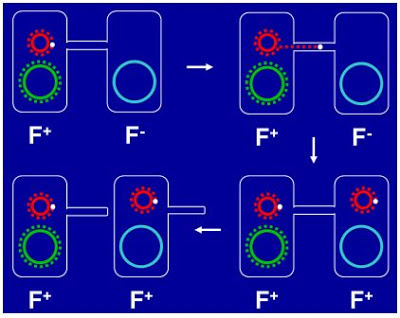1. Bacteria reproduce vegitatively by
a) Fission only
b) Fission and fragmentation
c) Fission, fragmentation and budding
d) None of the above
2. Bacteria reproduce asexually by
a) Conjugation
b) Amitosis
c) Meiosis
d) Transformation
3. Binary
fission in bacteria involves all
except
except
a)
Cell elongation
b) Cytokinesis
c) DNA duplication
d)
Spindle formation
4. Minute
bodies that are formed during fragmentation in bacteria are called
a)
Conidia
b) Gonidia
c) Microconidia
d)
Oospore
5. Endospore
formation is a method to tide over unfavorable condition which is generally
seen in
 |
| Endospore Formation |
a)
Gram positive bacteria
b) Gram negative bacteria
c) Gram positive bacteria and Gram negative bacteria
d)
Streptomycetes
6. Which of the following favors endospore
formation
a)
High concentration of nitrogenous nutrients
b) Low concentration of nitrogenous nutrients
c) Low concentration of oxygen
d)
None of these
7. The
partial diploids formed as a result of sexual reproduction n bacteria is termed
as
a)
Zygotes
b) haplo zygotes
c) prozygote
d)
merozygote
8. The
transfer of genetic material from one bacterium to another via virus is called
a)
Transformation
b) Conjugation
c) Recombination
d)
Transduction
9. The
uptake of DNA fragments from surroundings by a bacterium is termed as
a)
Transformation
b) Conjugation
c) Recombination
d) Transduction
10. The
unidirectional transfer of genetic material from a donor bacterium to recipient
bacterium by cell to cell contact is termed as
a)
Transformation
b) Conjugation
c) Recombination
d) Transduction
11.
The ability of a cell to take up DNA fragments from the surroundings is called
as
a)
Fitness
b) Fecundity
c) Competence
d)
Hfr
a)
Two F- cells
b) F-cell becomes F+
c) F- cell remains F- cell with a little DNA from F+ cell
d)
remains same without ant change
13. If
the F factor is attached to the bacterial genome the donor is called as
a)
F +
b) F++
c) F+ super strains
d)
Hfr strains
14. Specialized transduction is mediated by
a)
lytic phages
b) lysogenic phages
c) Both lytic and lysogenic phages
d)
T4 phages
15. Transduction
was discovered by
a)
Griffith
b) Zinder and Lederberg
c) Lederberg, Hayes and Woolman
d) Iwanowsky
Answers:
1-c
|
2-b
|
3-d
|
4-b
|
5-a
|
6-b
|
7-d
|
8-d
|
9-a
|
10-b
|
11-c
|
12-b
|
13-d
|
14-b
|
15-b
|
Tags:
Bacteria MCQ
Binary fission
Conjugation
Endospore
microbiology mcq
Recombination
Transduction
Transformation

